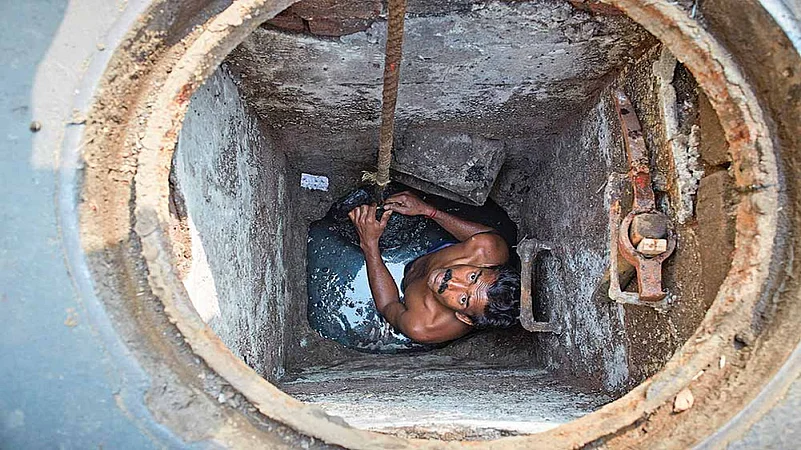What has the pandemic wrought on a field hidden from urban, middle-class India—a field that is, nonetheless, vital to India’s social and health indices? Sanitation is a fundamental aspect of social life, but it’s never much talked about—except in self-congratulatory government ads that tom-tom impressive statistics. The reality out there is far, far grimmer than what those ads would suggest, though—in both rural and urban areas. And the disruptions caused by the Covid pandemic have naturally extended to this infrastructural domain as well, creating unforeseen situations. For one, bad toilet conditions had always made for a gap between numbers and actual use. Open defecation was always rampant. And now, a variety of pandemic-related reasons—the fear of public toilets owing to them being hotbeds for coronavirus spread not the least of them—have made that practice even more rampant. This is a significant change in social behaviour with serious health implications that will only reveal themselves over time.
There’s another scourge from the past that very much lives in the present, and indeed, is thriving. More than 46,000 dry latrines have been enumerated as being in active use in semi-urban and rural India between the lockdowns of 2020-21—over and above this, hundreds of newer, dug-out pits have been found, showing that the trend is towards a further breakdown of sanitation infrastructure. The communities engaged in sanitation work are the worst-hit—the Prohibition of Employment as Manual Scavengers and their Rehabilitation (PEMSR) Act of 2013, and the strict ban have only made a modest dent on the scenario of everyday human degradation.
Informal settlements in regions of West Bengal bordering Bangladesh have been found to still have many ‘hanging toilets’ that the sanitation workers are forced to clean every single day even during the pandemic. Sanitation workers are forced to wash and wear already used masks and PPE kits to continue the cleaning work because they do not have access or the means to purchase newer ones. The challenges they face in the rural areas are of a completely different nature anyway. Here, the workers find neither any support nor any care as locals expect them to continue the cleaning work even in these perilous times. Right now, thousands of them have been displaced from the cities all over again by the lockdown. To find a meal a day, they find themselves doing the same work within the confines of a toilet even ‘back home.’
India’s urban scenario has a different set of issues—in some ways, as distant from the ideal as the rural, and only superficially better. Official sanitation coverage reports paint a rosier picture—but the approach, dominated by a focus on numbers, only serves to hide the chaotic, unwieldy mess that exists in practical terms. The government and other institutions spend enormous amounts on construction, but pay little ongoing attention to evaluating the ‘value of service’ of this infrastructure. This means actual toilet usage patterns were not realistically reflected in the surveys even in the pre-lockdown era because it was not combined with local community data. In terms of sanitary toilets, between the lockdowns of 2020-21, over one lakh toilets are reported to not have proper water coverage and around 33,700 lie completely abandoned. In its focus on construction and numbers, the government forgets a simple fact: toilet usage will not improve if sanitation infrastructure is not maintained and pipes and taps are in disrepair, regardless of the huge costs of construction on paper. This is a key reason why low-income communities are still choosing to defecate in the open even in urban India. This is a failure of practical, ground-oriented administration where it could conceivably happen.
Rural India presents a more distressing picture. In remote areas, the scope for all surveys ends anyway. And corruption at the local level brings about a total lack of innovation in ensuring sanitation coverage with even limited resources. One important aspect is the lack of electricity coverage in rural areas. Power cuts interfere with regular toilet usage: people in rural areas, faced with erratic water supply, are forced to rely on faraway toilets with running water. In remote areas, where piped water comes alive only 3-4 hours in a day, no expenditure on toilet construction will help. Therefore, it can be said that building a toilet in rural India simply does not guarantee toilet usage. The actual usage continues to fall in 2021: open defecation is estimated to have quadrupled. The pandemic has had its own effect on power supply—cuts sometimes extend to over 8 hours a day in rural India. This is over and above routine line faults. In rural Bihar, over 30 per cent households continue to suffer even when there is an access to sewer lines. Long power cuts continue to interfere with the realistic integration of improved water services, mainly piped water, with newly built toilets. Improved water infrastructure will not by itself improve sanitation services, yet it is the most important aspect in toilets moving beyond the traditional ‘pour flush’ technique. ‘Pour flush’ again burdens the sanitation workers: they are forced to carry water from distant water sources—hand-pumps and wells—to scrape and literally ‘scavenge’ these toilets with bare hands and no tools.
The spree of new toilet construction—which allows officialdom the leeway to call a place ‘Open Defecation Free’—in reality only gives free rein to corruption. Large contractors are often found to partner with bureaucrats in states like Uttar Pradesh, Madhya Pradesh and Rajasthan: hundreds of new toilets mushroomed in the villages, built almost overnight with substandard material, and these have literally become death traps. Cracked roofs and walls are commonplace, and the risk of injury is very real. The lockdown, on top of that, has brought every repair work to a complete standstill. In rural UP, repair work inevitably feeds into an ecosystem built around corruption: counterfeit transactions and forged invoices are par for the course.
This sham ensures that today, for all the data that is touted, lakhs of people defecate in the open even in big cities like Delhi and Mumbai—leave alone villages. This is the real face of an India that aims to build one toilet every two seconds and compete with other South Asian countries in terms of sanitation coverage. The obsession with construction is so much that neither initial data is brought to the table, nor guidelines ever followed before construction. Result? New dry latrines. What we need to do to overcome this grimy reality—and to support sanitation workers, among the most distressed of Indians, in these hard times—is to look beyond the superficiality of numbers. And revisit/survey previously built sanitary toilets, especially in rural India, focusing on the maintenance and value of service ‘one toilet, at a time’. Else, how will the government argue with a woman who says she dug small pits near her house because she did not want her child to walk alone for a long stretch to use a toilet, especially during the pandemic?
(Views are personal)
National convenor of Rehabilitation Research Initiative and secretary, Bhim Safai Karmachari Trade Union






















